There are 13 types of salamanders In Michigan including species like the Tiger salamander, Spotted Salamander and several others you’ve probably not heard of. Since a large portion of Michigan is surrounded by water, it houses plenty of habitats perfect for spotting salamanders.
If you come across a salamander in the wild it can easily be identified by its appearance, the region where it lives, its behavior, and the habitat it is living in. A species’ appearances and behavior also differ as it progresses through the various stages of its life, from egg to adult.
In total there are twenty-six amphibians that inhabit Michigan, also including frogs and toads. Michigan is home to around 13 endemic salamanders, and when knowing when and where to look you can find and analyze them in the wild easily.
Table of Contents
Salamanders in Michigan
1. Blue-spotted salamander
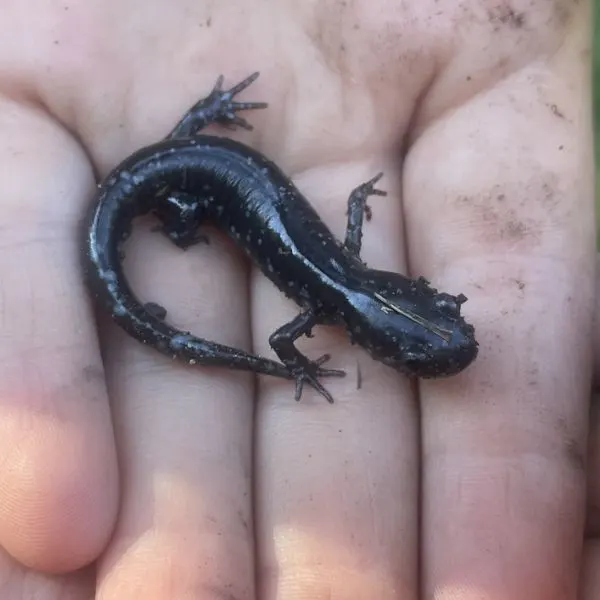
- Experience Level: Intermediate
- Family: Ambystomatidae
- Scientific Name: Ambystoma laterale
- Other Names: n/a
- Adult Size: 3 to 5 inches (7.62 to 12.7 cm)
- Lifespan: n/a
- Average Price Range: $25
The blue-spotted salamander is native to the eastern region of North America. They can be found all over Michigan, and other states in the U.S. The blue-spotted salamander lives in woodlands that are near swamps, rivers, streams, ponds, or other freshwater sources.
They burrow and spend most of their lives underground. Rocks, logs, and other outdoor debris are also hiding places used by this salamander.
Blue-spotted salamanders are active and out most during the spring season, spending this time breeding. When the rain comes migrating begins towards breeding pools. Females are capable of laying up to 500 eggs a year, attaching them to underwater plants.
After hatching the blue-spotted salamander is aquatic but will transform into a terrestrial adult by the summer. The blue-spotted salamander has blueish-black skin and is covered in blue, or white speckles. They have long bodies and small limbs.
Young larvae may have yellow speckles on their body, which turn blue once they are adults. There are around 12 to 14 costal grooves on their smooth moist bodies.
Males and female spotted salamanders look nearly identical, but females may be slightly larger. Slugs, worms, and other insects make up the majority of their diet. While not seen often, if attacked by a predator this salamander will whip around its tail, which secretes a toxic substance.
2. Eastern Newt
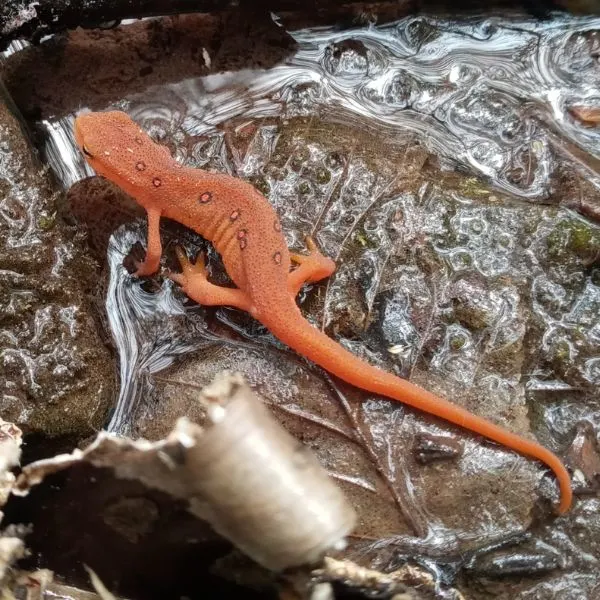
- Experience Level: Beginner
- Family: Salamandridae
- Scientific Name: Notophthalmus viridescens
- Other Names: Eastern Newt
- Adult Size: 3 to 6 inches (7 to 12.4 cm)
- Lifespan: 15 years
- Average Price Range: $20 to $30
The eastern newt is found in the eastern half of the United States, and in Michigan, you can find them all across the state. Deciduous forests, near lakes, ponds, and marshes are where this newt lives. Young larvae live in water, and it takes two months for them to transform into an eft and come on land. Adults live in water but are capable of surviving on land.
The eastern newt has yellow, olive, or tannish coloring. Their backs are covered in red spots with black bordering around them and greyish spots. Their stomachs are yellow, and also have black spots. Larvae of this species have gills and brown coloring. When in the eft stage they are bright orange coloring and have red spots on them.
Breeding for this species occurs from winter, until early spring. Males use tail movements and pheromones to court females. Females are able to lay between 200 to 400 eggs and place them underwater attached to vegetation.
The eastern newts feed on aquatic life like mollusks, insects, crustaceans, worms, eggs, and other small amphibians they may find. To defend themselves from predators a toxic substance is emitted from their body, and younger larvae emit a stronger toxin.
3. Tiger Salamander
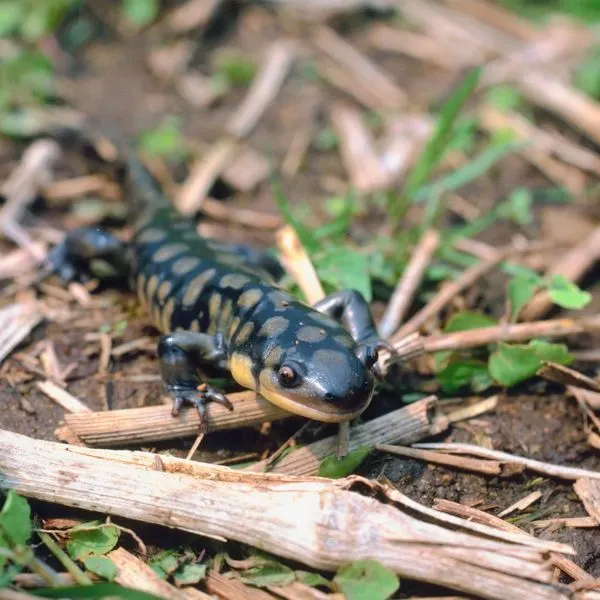
- Experience Level: Intermediate
- Family: Ambystomatidae
- Scientific Name: Ambystoma tigrinum
- Other Names: n/a
- Adult Size: 7 to 13 inches (17.78 to 33 cm)
- Lifespan: 15 years
- Average Price Range: $40
Tiger salamanders live in the Great Plains, Rocky Mountains, and Basins and Platuaeas land formations in North America. They are found in the U.S, Canada, and Mexico. In Michigan, tiger salamanders live all across the state. Forests with pools are where they live. Water is only used to breed and adults are fully terrestrial. Loose soils are prevalent in their habitats and are used for burrowing.
Captive breeding is not capable yet with this species. In the wild, a female may lay between 100 to 1,000 eggs. They hatch in around 19 to 50 days and take around 3 months to become adults. Tiger salamanders are the largest terrestrial salamander in Michigan and have gray, brown, or black coloring. They are covered in yellow blotches and markings.
The tiger salamander, like other ambystomatids, returns to their birthplace to breed and travel a long distance to get back home. Breeding may not occur yearly for a salamander, as they have a 50% chance of breeding more than once in their life. The fall is when migrations toward water pools occur, and the winter through spring is when breeding occurs.
Worms, slugs, snails, and other insects are what tiger salamanders eat the most. Compared to other salamanders they can be hardier, which makes them great for keeping as pets.
4. Four-toed Salmander
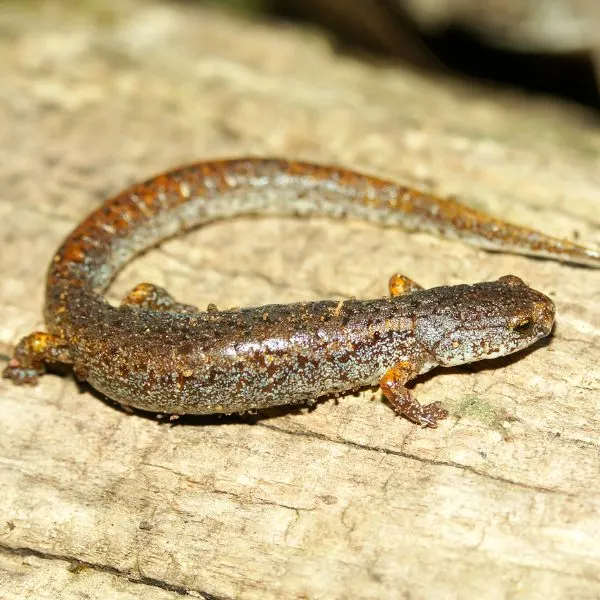
- Experience Level: Intermediate
- Family: Plethodontidae
- Scientific Name: Hemidactylium scutatum
- Other Names: n/a
- Adult Size: 2 to 4 inches (5.1 to 10.2 cm)
- Lifespan: 10 years
- Average Price Range: $40
The four-toed salamander is native to the eastern United States and has a scattered range across the region. In Michigan, this species is found all over the state. Four-toed salamanders live in moist, and dry woodlands, also sometimes swamps. They are small terrestrial amphibians, burrowing underground. They often are found underground sheltering together, hiding under rocks, leaf litter, and in rotting logs.
They have slender bodies, and at most only grow up to 4 inches. Four-toed salamanders have small limbs, and they are the only terrestrial salamander that has four toes. Their color is gray, or rusty brown. Their sides and back have grayish speckling. Their bellies are white and have some black spots.
The four-toed salamander breeds in the late winter, on the edges of the water. Between 18 to 41 eggs are laid by the females, and since they huddle together in groups they guard their eggs together also.
Predators of the four-toed salamander include birds, snakes, and small mammals like rats or skunks. To increase their chance of survivability their tails are able to detach from their bodies to allow for a quick escape. Beetles, ticks, spiders, worms, springtails, and other small invertebrates are what they eat.
5. Marbled Salamander
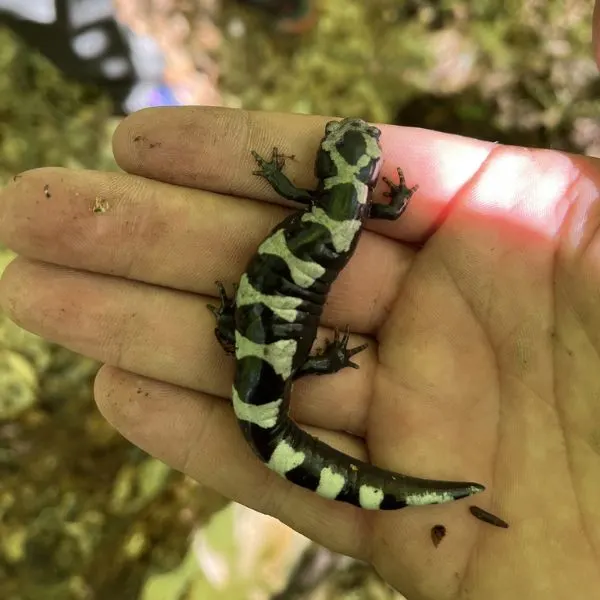
- Experience Level: Intermediate
- Family: Ambystomatidae
- Scientific Name: Ambystoma opacum
- Other Names: n/a
- Adult Size: 3.5 to 4.25 inches (9 to 10 cm)
- Lifespan: 4 years
- Average Price Range: $30
The marbled salamander is native to the southeastern United States. In Michigan, they are absent from most of the state. They inhabit the extreme southwestern portion of Michigan and have been documented in the Allegan, Van Buren, and Berrien counties. Deciduous woodlands, swamps, and most forests’ habitats are where they live. Marbled salamanders are burrowers, also seen under rocks or in leaf litter.
Medium in size, while not very long marbled salamanders are stout. They have black, or dark gray coloring. Their bellies are gray, or dark purple. A banding pattern covers their body. Females have grayish bands, while males are more white. When young, they may lack any bands but may appear with specks.
Breeding for the marbled salamander only occurs once a year in the fall. Females are able to lay 50 to 100 eggs, placing them in damp crevices. Their eggs will be guarded until it rains and floods their nesting site. After hatching they can take anywhere between 2 to 9 months to complete metamorphose, doing it quicker in warm temperatures.
Marbled salamanders are endangered in Michigan, but in their total range, they are listed as a species of least concern. The loss of the bottomland hardwoods with vernal pools is the main cause of their loss of population. Terrestrial invertebrates like ants, worms, beetles, and other bugs are what make up their diet. Similar to other salamanders they have poison glands on their tail to ward off predators.
6. Mudpuppy
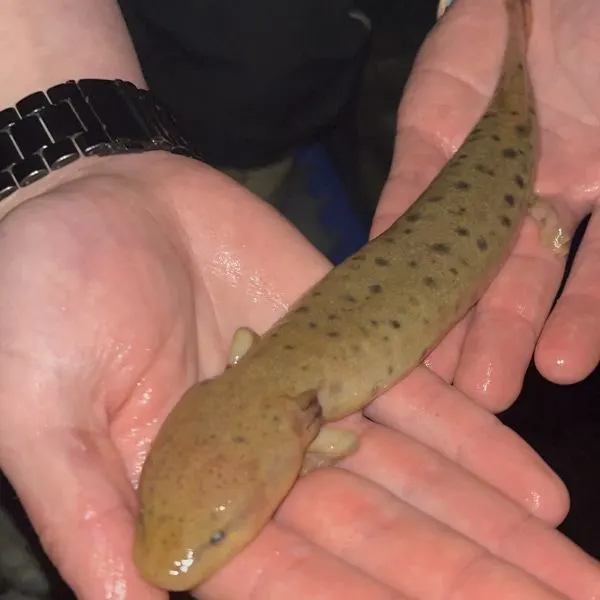
- Experience Level: Intermediate
- Family: Proteidae
- Scientific Name: Necturus maculosus
- Other Names: Waterdogs
- Adult Size: 8 to 19 inches (20.3 to 48.2 cm)
- Lifespan: 15 to 30 years
- Average Price Range: $10 to $20
Mudpuppies live all over Michigan and also inhabit other states in the southeastern United States. Mudpuppies are entirely aquatic. Rivers, ponds, streams, and lakes are where they live, one of the many salamanders in the U.S that never leave the water. They are usually nocturnal but may be active during the day in murky waters. Mudpuppies hide under aquatic debris like logs or large stones.
The mudpuppy has an elongated body, and a paddle tail to help them swim. Their limbs are small and used to navigate the bottoms of water sources. Their coloring is gray, or brownish, and they have a mottled pattern of bluish-black spots covering them. The gills of this salamander is external and noticeably sit near the sides of their neck, having red coloring.
Mudpuppies breed one time in the year during the fall and winter months. Females put their eggs under rocks, or other debris, laying between 20 to 200 eggs. Mudpuppies stay in their eggs for about 40 days before hatching.
Small teeth are located in their mouths, allowing them to feed on prey like spiders, small fish, mollusks, and crayfish. Mudpuppies have a flexible jaws like other amphibians, allowing them to eat larger animals. Fish, water snakes, and turtles are what feed on them in the wild.
7. Red-backed Salamander
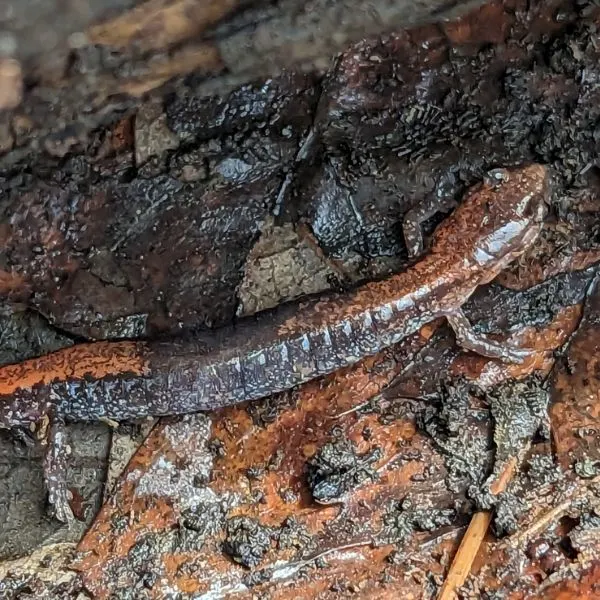
- Experience Level: Beginner
- Family: Plethodontidae
- Scientific Name: Plethodon cinereus
- Other Names: Eastern Red-backed Salamander. Northern Red-backed Salamander
- Adult Size: 2.2 to 3.9 inches (5.7 to 10 cm)
- Lifespan: 20 to 25 years
- Average Price Range: $15 to $30
Native to the eastern parts of the United States, the red-backed salamander range covers all of Michigan. One of Michigan’s most common salamanders, moist forests, urban areas, rocky hillsides, and woodlands with ponds are where they live. Red-backed salamanders are primarily terrestrial and may hide in moist vegetation, and under debris.
There are a variety of ways this salamander can appear. The lead-backed phase of this species is dark black and does not have any red pigmentation on its dorsal. They may be covered in light specks.
The red-backed phase of this salamander, from which their common name comes is their most common coloring. They have a red, or orangish streak running down their back, and on rare occasions, it may be white. Their bellies are white, with black specks.
Small invertebrates like mites, ants, and springtails are what this salamander eats. They’re nocturnal and have their breeding seasons in the June and July months. Around 4 to 17 eggs are laid by females yearly, taking up to 1 to 2 months to hatch.
Red-backed salamanders are common in their range and are not an endangered species. With a conservation status of least concern, in the right habitat, they may be seen congregating in large numbers together.
8. Small-mouthed Salamander
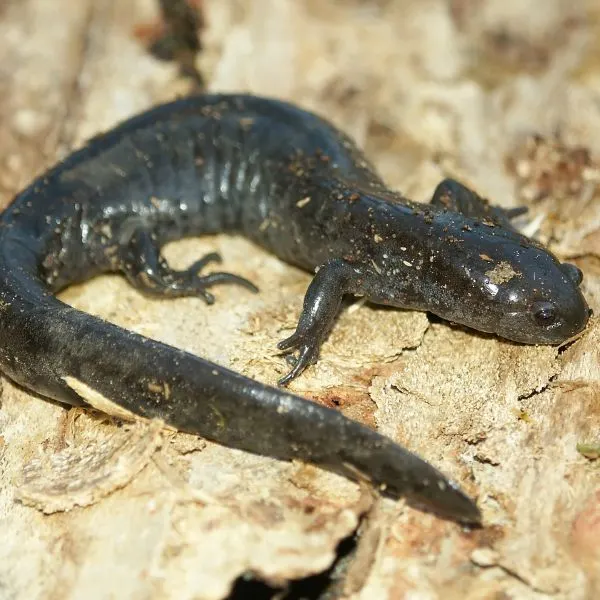
- Experience Level: Intermediate
- Family: Ambystomatidae
- Scientific Name: Ambystoma texanum
- Other Names: Texas salamander
- Adult Size: 4.3 to 7 inches (10.9 to 17.78 cm)
- Lifespan: 15 years
- Average Price Range: $15
The small-mouthed salamander can be found in the central states of the U.S. and are a rare amphibian to find in Michigan. Mainly residing in the southeastern portion of Michigan, small-mouthed salamanders have been reported in the Hillsdale, Wayne, Washtenaw, and Monore counties. Lowland forests and open habitats like grasslands that are near ponds are where this species lives.
With a rather plain appearance, small-mouthed salamanders have coloring ranging from gray to black. Their heads are small and blunt, and their mouth is short. They are covered in a lichen mottled pattern and have light specks on them.
Under rocks, and in vegetation is where this salamander might hide, and small-mouthed salamanders are terrestrial. In breeding, they go to ponds and other waters. Up to 700 eggs are laid, and they are explosive breeders triggered by heavy rainfall. When not breeding they spend their lives underground.
Slugs, worms, and crustaceans are what make up their diet. They have a secretive nature since they breed in the same areas as other larger amphibians like the marbled salamander. When attacked they stand in a defensive posture, waving their tail above its head. Like other similar species emitting a white toxin is done to defend from predators like snakes, or mammals.
9. Spotted Salamander
- Experience Level: Beginner
- Family: Ambystonmatidae
- Scientific Name: Ambystoma maculatum
- Other Names: Yellow Spotted Salamander
- Adult Size: 6 to 10 inches (15 to 25 cm)
- Lifespan: 30 years
- Average Price Range: $50
Found across the eastern parts of North America, the spotted salamander is a common species you may find. In Michigan, you can find them all across the state, and they have a conservation status of ‘least concern. Spotted salamanders live in mixed forests and woodlands habitats near permanent sources of freshwater. They may live near swamps, streams, lakes, or ponds.
Black, gray, green, dark brown, or bluish-black in color, the spotted salamander gets its name from the two uneven rows of spots that appear on its sides. Their spots are yellow, or orange and their bellies are grayish pink. Females are slightly bigger, and also have brighter colored spots.
The spotted salamander spends their lives underground in burrows but comes out to breed in heavy rain, or to eat. In the extreme cold, they become inactive to brumate. The spring season is when the spotted salamander breed and they use ponds or other water sources. Females lay up to 100 eggs and lay them in vegetation underwater.
To defend itself the spotted salamander spends a large part of its life hiding under things like leaves, or rocks. They can also secrete toxic mucous. Spotted salamanders eat terrestrial insects, and arthropods, coming out at night.
10. Western Lesser Siren
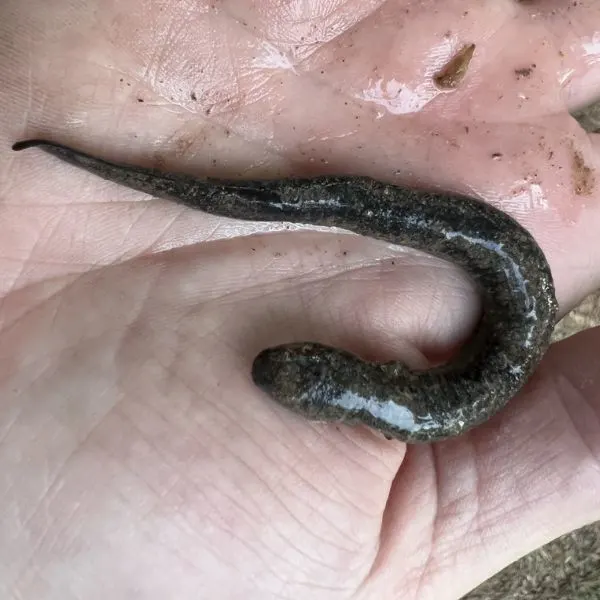
- Experience Level: Intermediate
- Family: Sirenidae
- Scientific Name: Siren intermedia nettingi
- Other Names: Dwarf siren
- Adult Size: 7 to 27 inches (17 to 69 cm)
- Lifespan: Siren intermedia nettingi
- Average Price Range: $30 to $80
Native to North America within the eastern United States, the western lesser siren subspecies is a salamander that lives in Michigan. Western lesser sirens are an aquatic species, and in the day hide within the dark aquatic depths. They live in ponds, lakes, ditches, streams, and other similar bodies of water.
Sirens like this species have elongated bodies and are often confused for eels. Western lesser sirens have three pairs of external gills that stick out the side of their head. Their front legs are small, and they have four toes. No back legs are present for this species. Their coloring varies from dark brown to black, and they have 31 to 38 costal grooves on them.
This salamander is able to lay up to 350 eggs, and their breeding occurs in spring. They are not common in Michigan and were considered extinct in the state until rediscovered.
Snails, worms, aquatic insects, and worms are what make up the majority of their diet. They are nocturnal, and not seen often since they live in the water. On extremely rainy nights it is possible for them to use their small legs to come on land. The pollution of the waters they live in is why this salamander has experienced a population decline, similar to other amphibians.
11. Northern Dusky Salamander
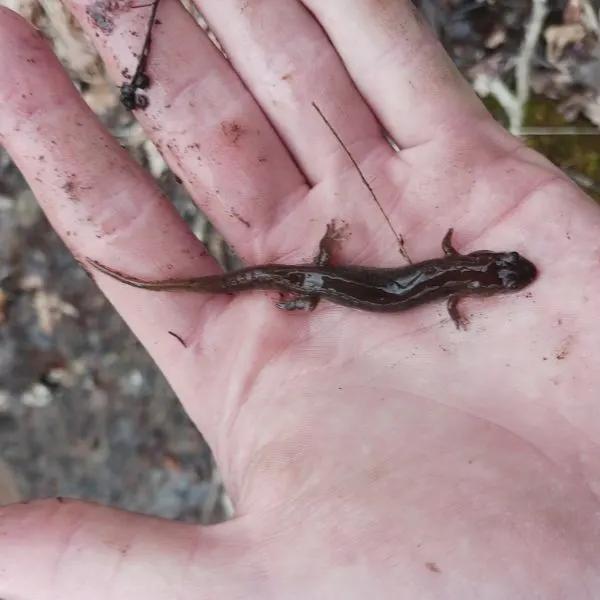
- Experience Level: Intermediate
- Family: Plethodontidae
- Scientific Name: Desmognathus fuscus
- Other Names: dusky salamander
- Adult Size: 2.52 to 5.59 inches (6.4 to 14.2 cm)
- Lifespan: 10 years
- Average Price Range: $25
In the eastern United States, and parts of Michigan, the northern dusky salamander is one of the amphibians you may come across. Streams, springs, or seepages in the deciduous forests and other woodlands are where the northern dusky salamander lives. They are lungless salamander that is partially aquatic and prefer to live in soft substrate.
A medium-sized, slender salamander, northern duskies when mature have brown coloring. When young they may appear olive or light tan. Their bellies have a salt-and-pepper translucent appearance. Northern dusky salamanders have a long knife-like tail, and a moist appearance.
Northern dusky salamanders breed in the spring and fall. They lay between 10 to 50 eggs, and it takes about 5 weeks for them to hatch. Northern dusky salamanders complete metamorphosis after the hatching and overwintering.
The northern dusky salamander comes out at night to feed on insects and other invertebrates. Like other salamanders, this species is a sign of a healthy habitat, and protecting their habitat is essential in keeping their populations sustained.
12. Southern Two-lined Salamander
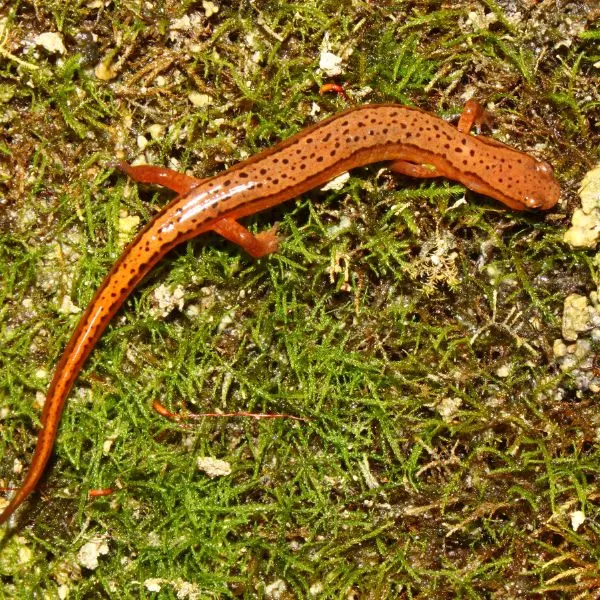
- Experience Level: Intermediate
- Family: Plethodontidae
- Scientific Name: Eurycea cirrigera
- Other Names: n/a
- Adult Size: 2.5 to 4 inches (6.35 to 10.16 cm)
- Lifespan: n/a
- Average Price Range: $15
The southern two-lined salamander is found in the eastern United States. This species lives in rocky streams and other bottomland habitats. Forests and swamps are habitats they are common in. The southern two-lined salamander is common in its range, but in Michigan, it was only discovered very recently.
This salamander is a small, and slender species. They have tan coloring, with dark lines that run down its body, which also gives them their name. Southern two-lined salamanders two black lines run all the way down to their tail. Southern two-lined salamanders have small limbs and around 14 costal grooves on their body.
In Michigan, this species is very rare, and like other salamanders, they have experienced population loss. They primarily live in streams during their mating season and move onto land during the other seasons. Roaches, millipedes, snails, and other small invertebrates are what this salamander eats.
13. Tremblay’s Salamander
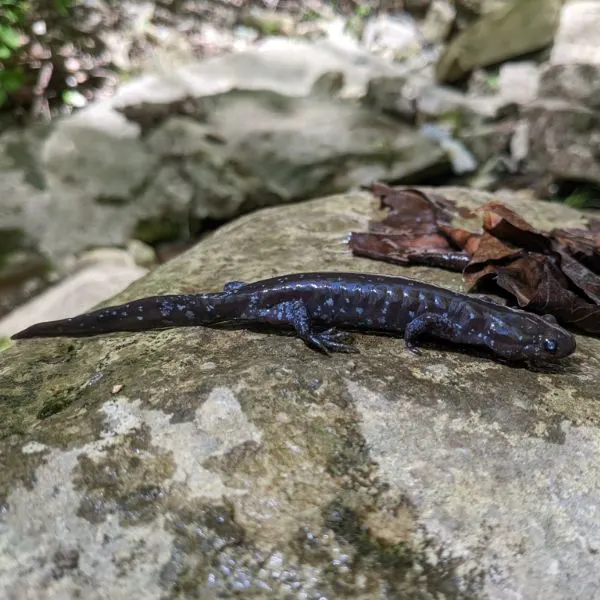
- Experience Level: Intermediate
- Family: Ambystomatidae
- Scientific Name: Ambystoma tremblayi
- Other Names: n/a
- Adult Size: 3.6 to 6.2 in. (9.3 to 16 cm)
- Lifespan: 25 years
- Average Price Range: n/a
The Tremblay’s salamander is found in the eastern United States, including Michigan. This salamander is a hybrid of the Jeffersons’ salamander, and the blue-spotted salamander and they are all females. They breed with similar salamanders in their range, only creating other females. The other hybrid is the silvery salamander.
Tremblays salamanders are mediums size species, with slender bodies. Their colors range from gray to black, with their stomach also being black. Spring is when this salamander is spotted the most, breeding with other similar species. They lay 6 to 10 eggs, which carry only the female DNA. They are not common, and not much is known about this hybrid salamander’s life in the wild.
FAQ
In Michigan what is the most common salamander?
In Michigan, there are around 13 species of salamander that lives in the wild. The red-backed salamander, mole salamander, mudpuppies, and spotted salamanders are some of the most common in the state.
You should not take any salamanders from the wild as it can lower their population, and there are many endangered species. In Michigan species like the small-mouthed salamander and marbled salamander are endangered, and have a population at risk.
Are the salamanders in Michigan dangerous?
Salamanders are generally harmless to humans, but there are a few things to be cautious about them. Amphibians like salamanders or frogs may carry dangerous bacteria like Salmonella, which can cause serious illness.
Salamanders also have a toxic substance that secretes from their body, which can irritate skin or eyes. All of the salamanders in Michigan are not dangerous, and humans are actually one of the main reasons for salamanders’ decline in the wild. You should not handle any salamanders unless necessary.
What is the largest salamander in Michigan?
The eastern tiger salamander is the largest salamander that lives in Michigan. This salamander is terrestrial and lives in woodlands, meadows, marshes, and other wet forest habitats. The tiger salamander is native to North America and inhabits regions within the United States, Mexico, and parts of Canada.
Where can you find salamanders in Michigan?
Near forested areas, with freshwaters like ponds and wetlands where you typically find salamanders. They hide under moist debris like stones, logs, or leaf litter. Some live on land, while others in the water.
The majority of salamanders are nocturnal, but they are sometimes seen on wet days. Rainy nights in the spring give the best opportunities for spotting salamanders outside.
Wrapping up
Spotting a salamander in the wild is a sign the habitat is healthy. Pollution and the destruction of the habitats salamanders live in are some of the reasons there are tons of salamander species losing their population, and becoming endangered. Drought is also a problem faced, as rain and water pools are needed for breeding.
Due to their size salamanders are keystone animals. As opportunistic feeders, small insects, spiders, small fish, and other life are what they eat. Salamanders are also an important food source for snakes, birds, small mammals, and even other amphibians.
If you see a salamander in the wild you should not take them from its natural habitat. Some do make good pets for the right owner. You must learn how to properly care for a salamander before getting one, and the different species each have their own needs. Salamanders are important animals in their ecosystem, and also interesting animals to learn about.
Other nearby states
